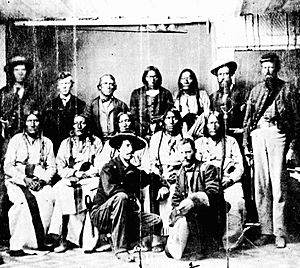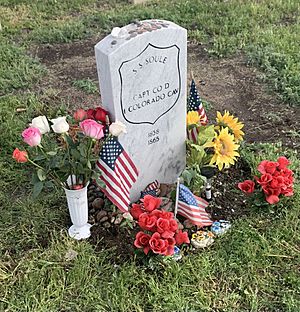Silas Soule facts for kids
Quick facts for kids
Silas S. Soule
|
|
|---|---|

Soule c. 1864
|
|
| Born | July 26, 1838 Bath, Maine, United States |
| Died | April 23, 1865 (aged 26) Denver, Colorado Territory, United States |
| Place of burial |
Riverside Cemetery (Denver, Colorado)
|
| Allegiance | United States |
| Service/ |
Union Army |
| Years of service | 1861–1865 |
| Rank | Captain |
| Unit | 1st Colorado Infantry 1st Colorado Cavalry |
| Commands held | Company D, 1st Colorado Cavalry |
| Battles/wars | American Civil War |
| Spouse(s) |
Thersa A. Coberly
(m. 1865) |
Silas Stillman Soule (/ˈsoʊl/ [sole]) (July 26, 1838 – April 23, 1865) was an American abolitionist, Kansas Territory Jayhawker, whose family aligned themselves with John Brown and Walt Whitman. Later, during the American Civil War, he joined the Colorado volunteers, rising to the rank of Captain in the Union Army. Silas Soule was in command of Company D, 1st Colorado Cavalry, which was present at Sand Creek on November 29, 1864, when he refused an order to join the Sand Creek massacre. During the subsequent inquiry, Soule testified against the massacre's commanding officer, John Chivington, and soon after, he was murdered in Denver.
Contents
Early life
Silas Soule was born into a family of abolitionists in Bath, Maine. He was raised in Maine and Massachusetts and, in 1854, his family became part of the newly formed New England Emigrant Aid Company, an organization whose goal was to help settle the Kansas Territory and bring it into the Union as a free state. His father and brother arrived in Kansas, near Lawrence (of which the Soule family was one of the founding families), in November 1854. Silas, his mother and two sisters came the following summer.
Shortly after the family's arrival at Coal Creek, a few miles south of Lawrence near present-day Vinland, Amasa Soule, Silas's father, established his household as a stop on the Underground Railroad. At the young age of 17, Silas was escorting slaves, escapees from Missouri, north to freedom. His sister, Anne Julia Soule Prentiss, told of her family's early experience in Maine, Massachusetts and Kansas in a 1929 interview: "Our house was on the 'Underground Railway'. John Brown was often there... My brother, Silas, and Brown were close friends. Silas went out on many a foray with him. I recall well when Brown came to our cabin one night with thirteen slaves, men, women and children. He had run them away from Missouri. Brown left them with us. Father would always take in all the Negroes he could. Silas took the whole thirteen from our home eight miles to Mr. Grover's stone barn..."
"Bleeding Kansas"
During these pre-war years, pro-slavery forces from Missouri and abolitionist forces from Kansas were engaged in open warfare. The fight was whether Kansas would be admitted to the Union as a slave or as a free state. This conflict, often called "Bleeding Kansas", enhanced the reputation of Silas Soule as a brave and resourceful fighter.
In July 1859, Soule was part of an action on the Missouri border. Twenty pro-slavery men had crossed into Kansas to look for escaped slaves. They ambushed a party led by Dr. John Doy, a physician in Lawrence, escorting 13 former slaves (eight men, three women and two children) toward safety in Iowa. The men from Missouri arrested Dr. Doy and sold the former slaves. Doy was soon tried and convicted in Missouri for abducting slaves and sentenced to five years in the local penitentiary. Soule and a group of other men from Lawrence decided to free Doy. Soule was sent into the jailhouse in St. Joseph where Doy was being held. Soule convinced the jailkeeper that he had a message from Doy's wife. The note, in fact, read "Tonight, at twelve o'clock." Later that night, they overpowered the jailer, freed Doy, and led him across the Missouri back to Kansas. When they reached Lawrence, they had their photo taken. This photo of "The Immortal Ten," now held by the Kansas State Historical Society, is widely circulated.
His skills at prison escapes came into use once again when John Brown was captured after his raid on Harper's Ferry where Brown was tried, convicted and sentenced to death by hanging. In November 1859, Soule visited the incarcerated Brown and offered to plan a jailbreak and help him flee from Virginia to hide out up north either in New York state or Canada. However, Brown told Soule that he had already decided to become a martyr for the abolitionist cause and willingly allowed himself to be executed, hoping his death would help bring on a war between North and South, frustrating Soule's planned rescue attempt. Thomas Wentworth Higginson put together a rescue attempt of two of Brown's men, Albert Hazlett and Aaron Stevens, during which Soule posed as a drunken Irishman and got himself arrested for brawling. Put into the Charles Town jail for the night, he charmed the jailer into letting him out of his cell for a short while in which Soule contacted the two men as well as John Brown once again with a second offer to help all three of them escape that night. Brown, Hazlett and Stevens all refused to be sprung from the jail. Afterwards upon his release from the Charles Town jail, Soule traveled to Boston, where he often met with various abolitionists and also befriended the poet Walt Whitman.
Life in Colorado and the Civil War

In May 1860, Soule, along with his brother William L.G., and his cousin, Sam Glass, went to the gold fields in Colorado. He dug for gold and worked in a blacksmith shop.
In 1861, after the breakout of the Civil War, Soule enlisted in Company K, 1st Colorado Infantry (the 1st Regiment of Colorado Volunteers) and took part in the victorious New Mexico Campaign of 1862, including the key Battle of Glorieta Pass. He made his way up the ranks, and in November 1864 was assigned the command of Company D, 1st Colorado Cavalry (the 1st Colorado Volunteer Cavalry Regiment).
The Sand Creek Massacre
On November 29, 1864, Captain Soule and Lieutenant Joseph Cramer and the Companies they commanded were at Sand Creek, Colorado. Colonel John Chivington ordered the Third Colorado Cavalry to attack Black Kettle's encampment of Cheyenne. However, Soule saw that the Cheyennes were flying the Union flag as a sign of peace, and when told to attack, he and Cramer ordered their men to hold their fire and stay put. Most of the other Third Colorado Cavalry however, attacked the encampment. The resulting action became known as the Sand Creek Massacre, one of the most notorious acts of mass murder in U.S. history. Soule described what followed in a letter to his former commanding officer and friend, Major Edward W. Wynkoop:
"I refused to fire, and swore that none but a coward would, for by this time hundreds of women and children were coming towards us, and getting on their knees for mercy. I tell you Ned it was hard to see little children on their knees have their brains beat out by men professing to be civilized. ... I saw two Indians hold one of another's hands, chased until they were exhausted, when they kneeled down, and clasped each other around the neck and were both shot together."
The Sand Creek Massacre sparked outrage and shock around the country. The U.S. Army and U.S. Congress began investigations into the Sand Creek Massacre. Soule along with others, testified against Chivington in a military court of inquiry beginning in February 1865. His testimony about the events at Sand Creek led to Chivington’s resignation, Colorado’s Second Territorial Governor John Evans’ dismissal and the U.S. Congress refusing the U.S. Army's request for thousands of men for a general war against the Plains Indians.
Marriage
On April 1, 1865, Silas married Thersa A. "Hersa" Coberly. Twenty-two days into the marriage, Silas was murdered.
Death
On April 23, 1865, two months after testifying before a military commission investigating the Sand Creek Massacre and three weeks after getting married, Soule was on duty as Provost Marshal of the Colorado Territory in Denver, when he went to investigate guns being fired around 10:30 p.m. With his pistol out, Soule went around a corner and faced Charles Squier, one of his two assassins. Soule fired the first shot and wounded Squier's left arm, but Squier fired a bullet into Soule's right cheek bone. Soule was dead before help could arrive. Squier dropped his pistol and ran before he could be arrested by the authorities. Soule's assassination occurred two weeks after the end of the Civil War.
One of Soule’s assassins fled the scene, but Squier was eventually caught and brought back to Denver for a court-martial. However, the officer who captured Squier was found dead in a Denver hotel, and at the same time Squier escaped to New York where his father lived. Once there he held various jobs, and tried to rejoin the Army, but was rejected. Squier then fled to Central America trying to avoid the law. His legs were crushed in a railroad accident and he later died from gangrene in 1869. Despite his crime, he was buried in New York with honors.
Remembrance
Capt. Silas S. Soule is buried at Riverside Cemetery in Denver, Colo., and Lt. Joseph A. Cramer, who along with Soule, also refused to participate in the Sand Creek Massacre and ordered the Companies they commanded, not to participate in the Sand Creek Massacre, is buried in Kansas. From 1998 to 2018 a Spiritual Healing Run/Walk was held in November to honor those killed at Sand Creek. It began at the Sand Creek Massacre National Historic Site in southeastern Colorado and concluded on the west steps of the Colorado State Capitol. Starting in 2010, a memorial ceremony was also held at Soule's grave site, honoring Soule and Cramer, and at 15th and Arapahoe Streets in Denver, where a memorial plaque, honoring Soule, was installed nearby the location of his murder, before the Spiritual Healing Run/Walk proceeded to the Colorado State Capitol. Representatives from the Northern Cheyenne Tribe of Montana, the Northern Arapaho Tribe of Wyoming, the Southern Cheyenne Tribe of Oklahoma, the Arapaho Tribe of Oklahoma, the National Park Service and the Colorado History Museum conducted these memorial ceremonies.
U.S. Board on Geographic Names
In March 2019, a Denver Journalist submitted an application to the federal agency handling U.S. geographic name changes, to change the name from Mount Evans to Mount Soule. During a week-long series of meetings between this Journalist and the Cheyenne Traditionalists, for this Journalist's research on a book about the Cheyenne Nation, the topic of changing Mount Evans’ name arose. As descendants of the survivors of the Sand Creek Massacre, these Cheyenne Traditionalists worked with U.S. Colorado Sen. Ben Nighthorse Campbell, to establish federal legislation determining the location of the Sand Creek Massacre, along with having it designated as a National Historic Site and held in trust by the National Park Service. The Cheyenne Traditionalists, other Cheyenne/Native Americans and non-Native Americans, with whom this Journalist has spoken, agreed that Soule's name would connect important historical dots of Colorado's history and at the same time honor Soule. All of these people also believed it would be better not to reuse a repetitive place name or restore the original peak name since neither had much historical significance in connection to the Sand Creek Massacre. This application to rename Mount Evans to Mount Soule, along with six others (one was rescinded), are pending until a vote is held by the U.S. Board on Geographic Names.




